Mechanistic Kinetic Modelling Framework for the Conversion of Waste Crude Glycerol to Value-Added Hydrogen-Rich Gas
Abstract
:1. Introduction
2. Preceding Experimental and Analytical Work
2.1. Catalyst Development and Kinetic Testing
2.2. Preceding Reaction Rate Power Law Modelling
- Steam reforming.
- Total oxidation (where the formation of carbon monoxide was not observed).
- Carbon dioxide methanation (where the formation of methane was observed).
2.3. Preceding Reactor Modelling in COMSOL
3. Kinetic Analysis
3.1. Verification of Absence of Transport Limitations
3.2. Mechanistic Model Development
3.2.1. Glycerol Steam Reforming (SR)
3.2.2. Total Oxidative Reforming (TOR)
3.2.3. Carbon Dioxide (CO2) Methanation
4. Results and Discussion
4.1. Parameter Estimation
4.2. Thermodynamic Scrutiny
4.3. Comparison with Other Literature Studies
5. Reactor Simulation
5.1. Modelling Approach and Solution Method
5.2. Review and Discussion of Simulation Results
5.2.1. Model Validation
5.2.2. Comparison between Modelling Approaches
5.2.3. Effects of Temperature
5.2.4. Effects of Axial Dispersion
5.2.5. Effects of Space Velocity on Reactor Performance
5.2.6. Effects of Reactor Catalyst Bed Length on Conversion
6. Conclusions
Author Contributions
Funding
Conflicts of Interest
References
- Knothe, G.; Razon, L.F. Biodiesel fuels. Prog. Energy Combust. Sci. 2017, 58, 36–59. [Google Scholar] [CrossRef]
- I.E. Agency. Renewables 2020: Analysis and Forecast to 2025. Paris. 2020. Available online: https://www.iea.org/reports/renewables-2020 (accessed on 15 December 2021).
- Quispe, C.A.G.; Coronado, C.J.R.; Carvalho, J.A., Jr. Glycerol: Production, consumption, prices, characterization and new trends in combustion. Renew. Sustain. Energy Rev. 2013, 27, 475–493. [Google Scholar] [CrossRef]
- He, Q.; McNutt, J.; Yang, J. Utilization of the residual glycerol from biodiesel production for renewable energy generation. Renew. Sustain. Energy Rev. 2017, 71, 63–76. [Google Scholar] [CrossRef]
- Chilakamarry, C.R.; Sakinah, A.M.M.; Zularisam, A.W.; Pandey, A. Glycerol waste to value added products and its potential applications. Syst. Microbiol. Biomanuf. 2021, 1, 378–396. [Google Scholar] [CrossRef]
- Bagnato, G.; Iulianelli, A.; Sanna, A.; Basile, A. Glycerol Production and Transformation: A Critical Review with Particular Emphasis on Glycerol Reforming Reaction for Producing Hydrogen in Conventional and Membrane Reactors. Membranes 2017, 7, 17. [Google Scholar] [CrossRef] [PubMed]
- Vivek, N.; Sindhu, R.; Madhavan, A.; Anju, A.J.; Castro, E.; Faraco, V.; Pandey, A.; Binod, P. Recent advances in the production of value added chemicals and lipids utilizing biodiesel industry generated crude glycerol as a substrate—Metabolic aspects, challenges and possibilities: An overview. Bioresour. Technol. 2017, 239, 507–517. [Google Scholar] [CrossRef]
- Nda-Umar, U.; Ramli, I.; Taufiq-Yap, Y.; Muhamad, E. An Overview of Recent Research in the Conversion of Glycerol into Biofuels, Fuel Additives and other Bio-Based Chemicals. Catalysts 2018, 9, 15. [Google Scholar] [CrossRef] [Green Version]
- Adeniyi, A.G.; Ighalo, J.O. A review of steam reforming of glycerol. Chem. Pap. 2019, 73, 2619–2635. [Google Scholar] [CrossRef]
- Roslan, N.A.; Abidin, S.Z.; Ideris, A.; Vo, D.-V.N. A review on glycerol reforming processes over Ni-based catalyst for hydrogen and syngas productions. Int. J. Hydrogen Energy 2020, 45, 18466–18489. [Google Scholar] [CrossRef]
- Saeidabad, N.G.; Noh, Y.S.; Eslami, A.A.; Song, H.T.; Kim, H.D.; Fazeli, A.; Moon, D.J. A Review on Catalysts Development for Steam Reforming of Biodiesel Derived Glycerol; Promoters and Supports. Catalysts 2020, 10, 910. [Google Scholar] [CrossRef]
- Hejna, A.; Kosmela, P.; Formela, K.; Piszczyk, Ł.; Haponiuk, J.T. Potential applications of crude glycerol in polymer technology–Current state and perspectives. Renew. Sustain. Energy Rev. 2016, 66, 449–475. [Google Scholar] [CrossRef]
- Anitha, M.; Kamarudin, S.K.; Kofli, N.T. The potential of glycerol as a value-added commodity. Chem. Eng. J. 2016, 295, 119–130. [Google Scholar] [CrossRef]
- Carlucci, C. A Focus on the Transformation Processes for the Valorization of Glycerol Derived from the Production Cycle of Biofuels. Catalysts 2021, 11, 280. [Google Scholar] [CrossRef]
- Canela-Xandri, A.; Balcells, M.; Villorbina, G.; Christou, P.; Canela-Garayoa, R. Preparation and Uses of Chlorinated Glycerol Derivatives. Molecules 2020, 25, 2511. [Google Scholar] [CrossRef]
- Bozkurt, Ö.D.; Tunç, F.M.; Bağlar, N.; Çelebi, S.; Günbaş, İ.D.; Uzun, A. Alternative fuel additives from glycerol by etherification with isobutene: Structure–performance relationships in solid catalysts. Fuel Process. Technol. 2015, 138, 780–804. [Google Scholar] [CrossRef]
- Agarwal, A.K.; Gupta, J.G.; Dhar, A. Potential and challenges for large-scale application of biodiesel in automotive sector. Prog. Energy Combust. Sci. 2017, 61, 113–149. [Google Scholar] [CrossRef]
- Ghani, A.A.; Torabi, F.; Ibrahim, H. Kinetics of hydrogen production by the autothermal reforming of crude glycerol over modified nickel supported catalyst. J. Environ. Chem. Eng. 2017, 5, 5827–5835. [Google Scholar] [CrossRef]
- Sundari, R.; Vaidya, P.D. Reaction Kinetics of Glycerol Steam Reforming Using a Ru/Al2O3 Catalyst. Energy Fuels 2012, 26, 4195–4204. [Google Scholar] [CrossRef]
- Cheng, C.K.; Foo, S.Y.; Adesina, A.A. Glycerol Steam Reforming over Bimetallic Co-Ni/Al2O3. Ind. Eng. Chem. Res. 2010, 49, 10804–10817. [Google Scholar] [CrossRef]
- Authayanun, S.; Arpornwichanop, A.; Paengjuntuek, W.; Assabumrungrat, S. Thermodynamic study of hydrogen production from crude glycerol autothermal reforming for fuel cell applications. Int. J. Hydrogen Energy 2010, 35, 6617–6623. [Google Scholar] [CrossRef]
- Liu, Y.J.; Lawal, A. Kinetic study of autothermal reforming of glycerol in a dual layer monolith catalyst. Chem. Eng. Process 2015, 95, 276–283. [Google Scholar] [CrossRef]
- Ghani, A.A.; Torabi, F.; Ibrahim, H. Autothermal reforming process for efficient hydrogen production from crude glycerol using nickel supported catalyst: Parametric and statistical analyses. Energy 2018, 144, 129–145. [Google Scholar] [CrossRef]
- Ghani, A.M.A. Hydrogen Production by the Cataylitic Auto-Thermal Reforming of Synthetic Crude Glycerol in a Packed Bed Tubular Reactor. Master’s Thesis, University of Regina, Regina, SK, Canada, 2015. [Google Scholar]
- Afabor, E.; Salama, A.; Ibrahim, H. Packed bed reactor modeling of the catalytic auto-thermal reforming of synthetic crude glycerol. J. Environ. Chem. Eng. 2017, 5, 4850–4857. [Google Scholar] [CrossRef]
- Levenspiel, O. Chemical Reaction Engineering, 3rd ed.; Wiley: New York, NY, USA, 1999. [Google Scholar]
- Froment, G.F.; Bischoff, K.B.; de Wilde, J. Chemical Reactor Analysis and Design, 3rd ed.; Wiley: Hoboken, NJ, USA, 2011. [Google Scholar]
- Mears, D.E. Tests for Transport Limitations in Experimental Catalytic Reactors. Ind. Eng. Chem. Process Des. Dev. 1971, 10, 541–547. [Google Scholar] [CrossRef]
- Mears, D.E. Diagnostic criteria for heat transport limitations in fixed bed reactors. J. Catal. 1971, 20, 127–131. [Google Scholar] [CrossRef]
- Vannice, M.A. Kinetics of Catalytic Reactions, 1st ed.; Springer: New York, NY, USA, 2005. [Google Scholar]
- Hu, Y.H.; Ruckenstein, E. Transient Kinetic Studies of Partial Oxidation of CH4. J. Catal. 1996, 158, 260–266. [Google Scholar] [CrossRef]
- Dinh, D.K.; Kang, H.S.; Jo, S.; Lee, D.H.; Song, Y.-H. Partial oxidation of diesel fuel by plasma—Kinetic aspects of the reaction. Int. J. Hydrogen Energy 2017, 42, 22756–22764. [Google Scholar] [CrossRef]
- Ibrahim, H.H.; Idem, R.O. Kinetic studies of the partial oxidation of isooctane for hydrogen production over a nickel–alumina catalyst. Chem. Eng. Sci. 2006, 61, 5912–5918. [Google Scholar] [CrossRef]
- Oluku, I.; Khan, F.; Idem, R.; Ibrahim, H. Mechanistic kinetics and reactor modelling of hydrogen production from the partial oxidation of diesel over a quartenary metal oxide catalyst. Mol. Catal. 2018, 451, 255–265. [Google Scholar] [CrossRef]
- Hohn, K.L.; Lin, Y.C. Catalytic partial oxidation of methanol and ethanol for hydrogen generation. ChemSusChem 2009, 2, 927–940. [Google Scholar] [CrossRef]
- Beretta, A.; Groppi, G.; Lualdi, M.; Tavazzi, I.; Forzatti, P. Experimental and Modeling Analysis of Methane Partial Oxidation: Transient and Steady-State Behavior of Rh-Coated Honeycomb Monoliths. Ind. Eng. Chem. Res. 2009, 48, 3825–3836. [Google Scholar] [CrossRef]
- Battin-Leclerc, F. Detailed chemical kinetic models for the low-temperature combustion of hydrocarbons with application to gasoline and diesel fuel surrogates. Prog. Energy Combust. Sci. 2008, 34, 440–498. [Google Scholar] [CrossRef] [Green Version]
- Huang, H.; Wang, Z.; Liu, H.; Sun, H.; Wei, Y.; Zhou, X. A kinetic model for analyzing partial oxidation reforming of heavy hydrocarbon over a novel self-sustained electrochemical promotion catalyst. Int. J. Hydrogen Energy 2012, 37, 15125–15134. [Google Scholar] [CrossRef]
- Koschany, F.; Schlereth, D.; Hinrichsen, O. On the kinetics of the methanation of carbon dioxide on coprecipitated NiAl(O)x. Appl. Catal. B-Environ. 2016, 181, 504–516. [Google Scholar] [CrossRef]
- Amaral, R. Kinetics of CO2 Methanation over a Ni Alumina Industrial Catalyst. Master’s Thesis, University of Lisbon, Lisbon, Portugal, 2016. [Google Scholar]
- Weatherbee, G.D.; Bartholomew, C.H. Hydrogenation Of CO2 On Group-Viii Metals. 2. Kinetics And Mechanism Of CO2 Hydrogenation On Nickel. J. Catal. 1982, 77, 460–472. [Google Scholar] [CrossRef]
- Halabi, M.H.; de Croon, M.H.J.M.; van der Schaaf, J.; Cobden, P.D.; Schouten, J.C. Intrinsic kinetics of low temperature catalytic methane–steam reforming and water–gas shift over Rh/CeαZr1−αO2 catalyst. Appl. Catal. A Gen. 2010, 389, 80–91. [Google Scholar] [CrossRef]
- Adhikari, S.; Fernando, S.D.; Haryanto, A. Kinetics and Reactor Modeling of Hydrogen Production from Glycerol via Steam Reforming Process over Ni/CeO2 Catalysts. Chem. Eng. Technol. 2009, 32, 541–547. [Google Scholar] [CrossRef]
- Pant, K.K.; Jain, R.; Jain, S. Renewable hydrogen production by steam reforming of glycerol over Ni/CeO2 catalyst prepared by precipitation deposition method. Korean J. Chem. Eng. 2011, 28, 1859–1866. [Google Scholar] [CrossRef]
- Hemings, E.B.; Cavallotti, C.; Cuoci, A.; Faravelli, T.; Ranzi, E. A Detailed Kinetic Study Of Pyrolysis And Oxidation Of Glycerol (Propane-1,2,3-Triol). Combust. Sci. Technol. 2012, 184, 1164–1178. [Google Scholar] [CrossRef]
- Nguyen, T.H.; Lamacz, A.; Krzton, A.; Ura, A.; Chalupka, K.; Nowosielska, M.; Rynkowski, J.; Djega-Mariadassou, G. Partial oxidation of methane over Ni-0/La2O3 bifunctional catalyst II: Global kinetics of methane total oxidation, dry reforming and partial oxidation. Appl. Catal. B-Environ. 2015, 165, 389–398. [Google Scholar] [CrossRef]
- Rout, K.R.; Jakobsen, H.A. A numerical study of fixed bed reactor modelling for steam methane reforming process. Can. J. Chem. Eng. 2015, 93, 1222–1238. [Google Scholar] [CrossRef]
- Muthukumar, P.; Singhal, A.; Bansal, G.K. Thermal modeling and performance analysis of industrial-scale metal hydride based hydrogen storage container. Int. J. Hydrogen Energy 2012, 37, 14351–14364. [Google Scholar] [CrossRef]
- Halabi, M.; Decroon, M.; Vanderschaaf, J.; Cobden, P.; Schouten, J. Modeling and analysis of autothermal reforming of methane to hydrogen in a fixed bed reformer. Chem. Eng. J. 2008, 137, 568–578. [Google Scholar] [CrossRef]
- Lordanidis, A.A. Mathematical Modeling of Catalytic Fixed Bed Reactors. Ph.D. Thesis, University of Twente, Enschede, The Netherlands, 2002. [Google Scholar]
- Jimmy, U.; Mohamedali, M.; Ibrahim, H. Thermodynamic Analysis of Autothermal Reforming of Synthetic Crude Glycerol (SCG) for Hydrogen Production. ChemEngineering 2017, 1, 4. [Google Scholar] [CrossRef] [Green Version]
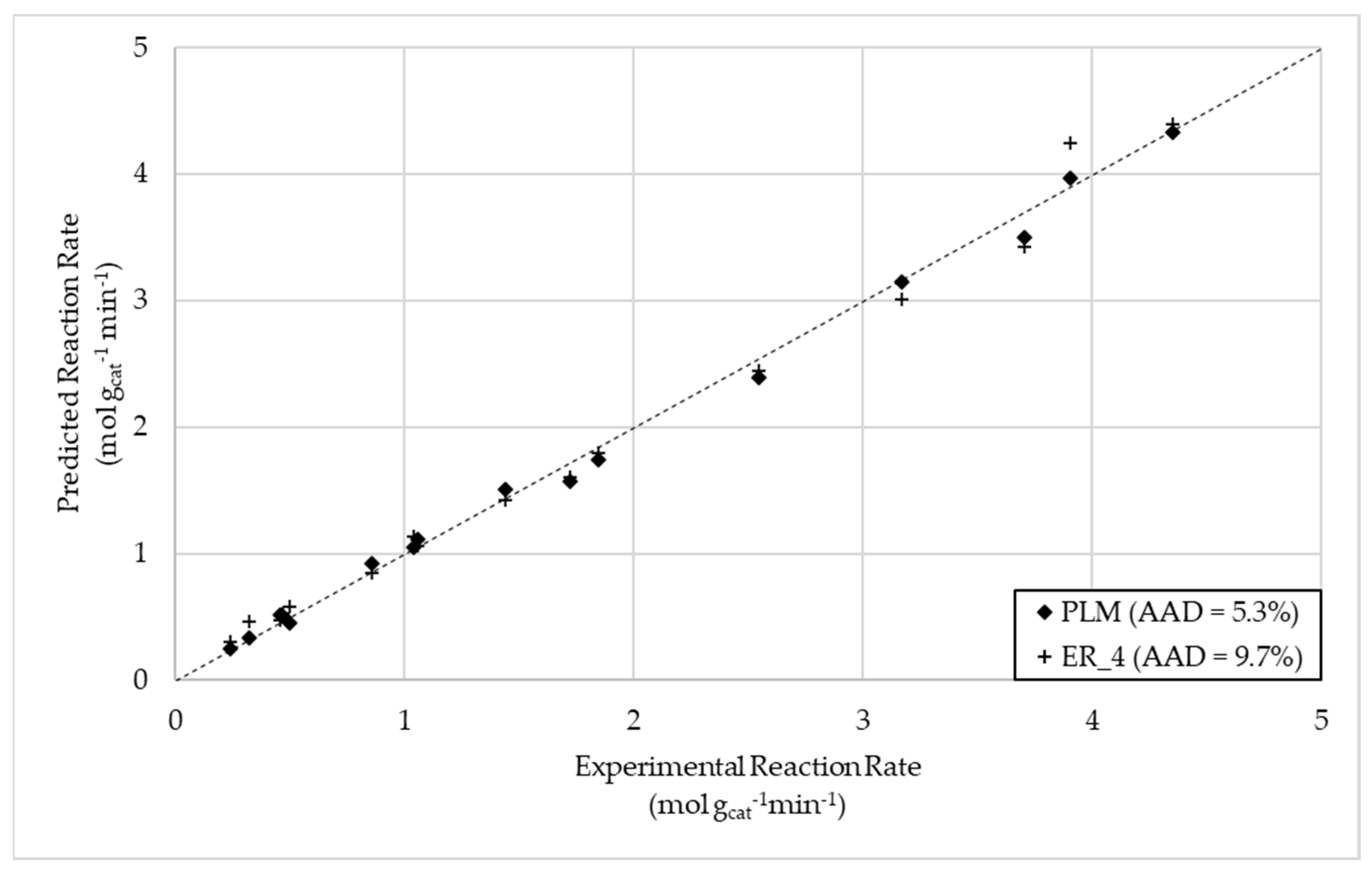
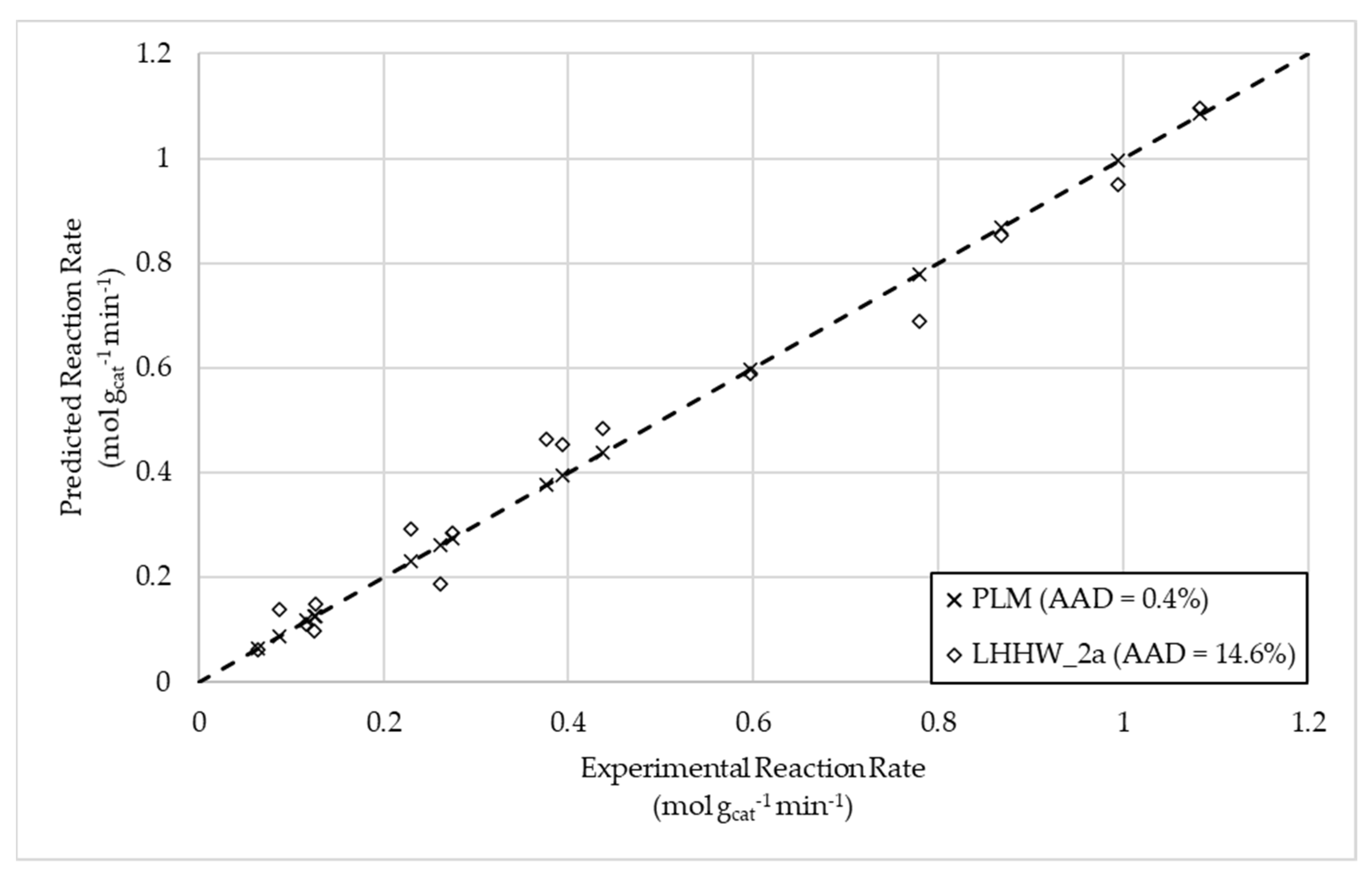


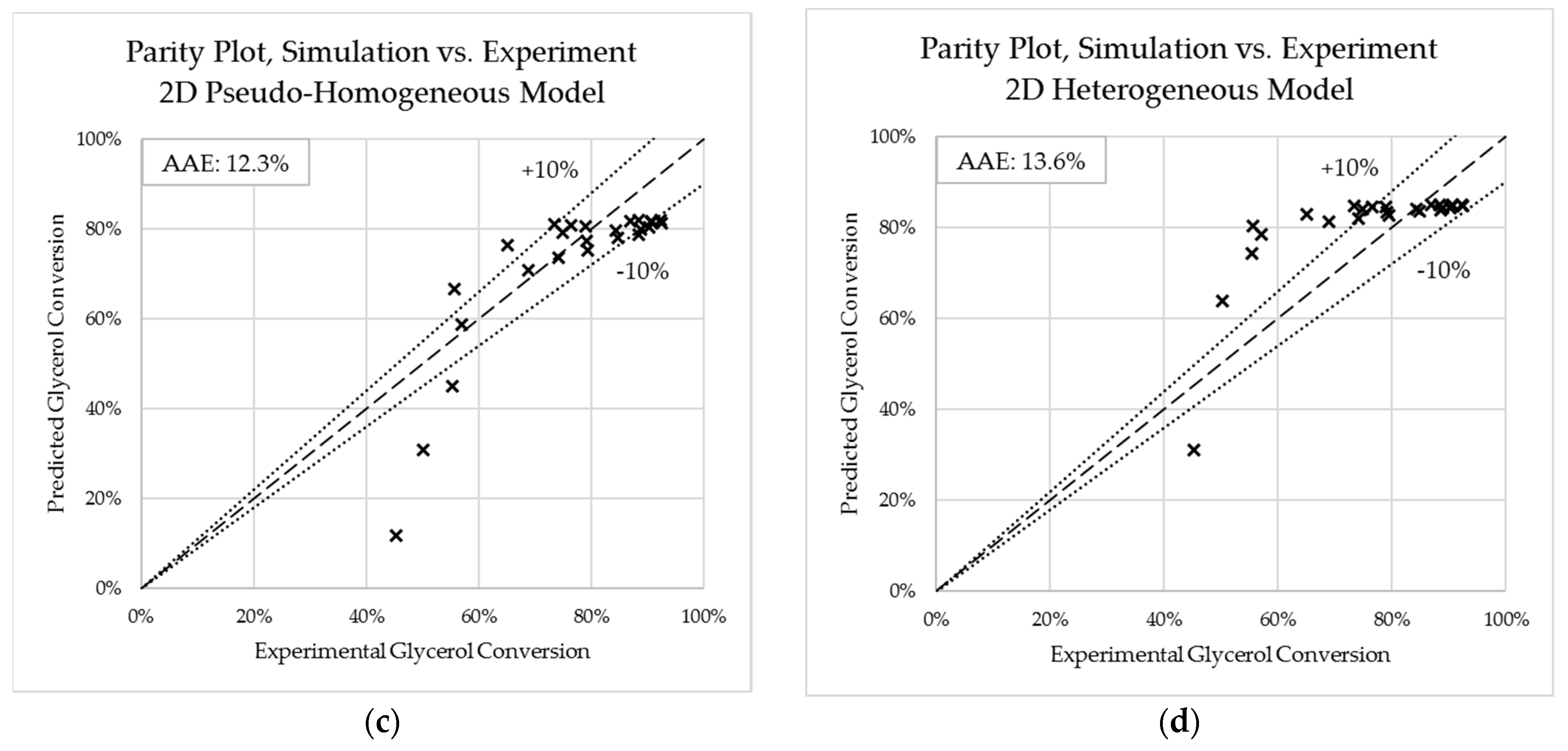
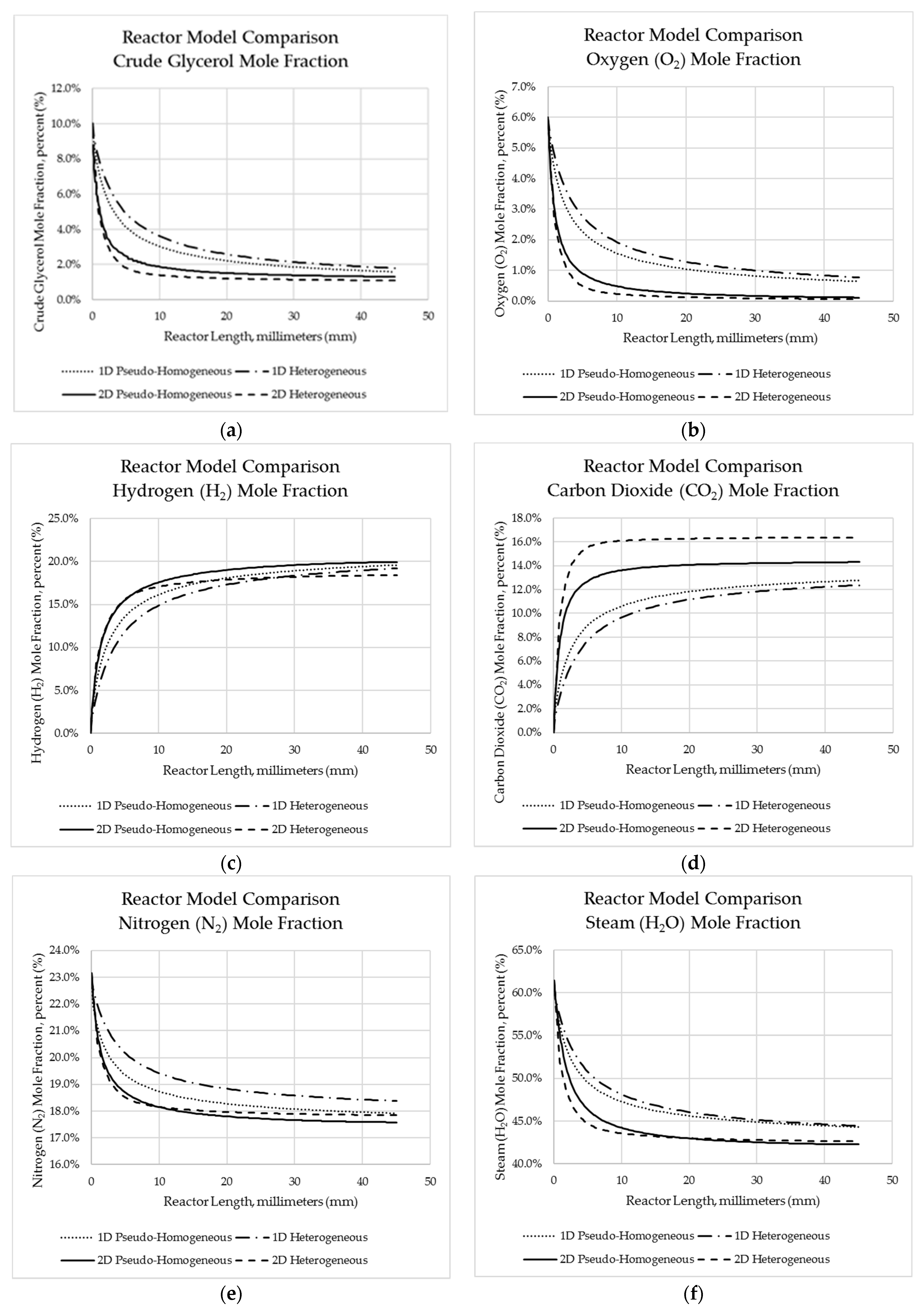
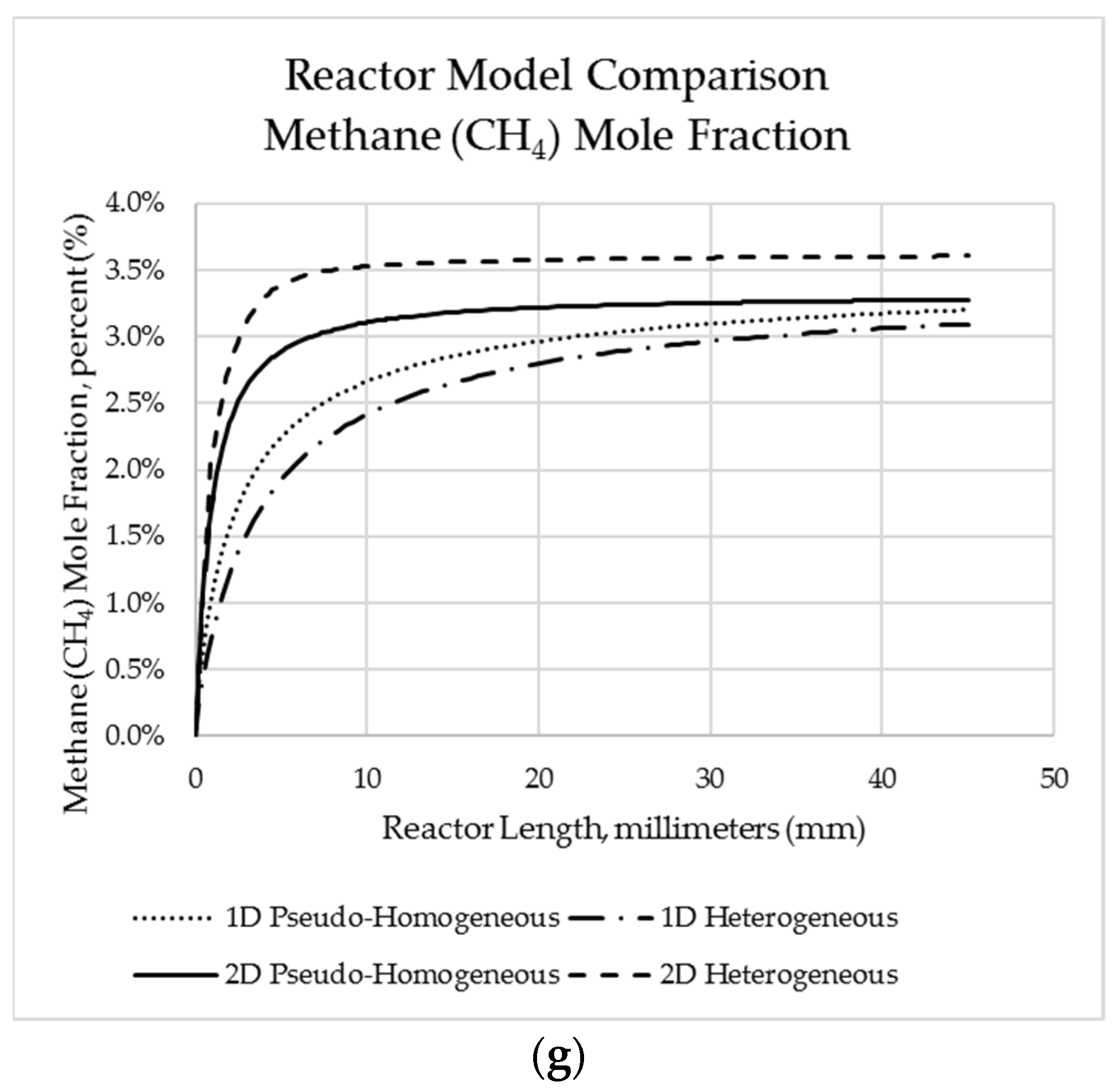
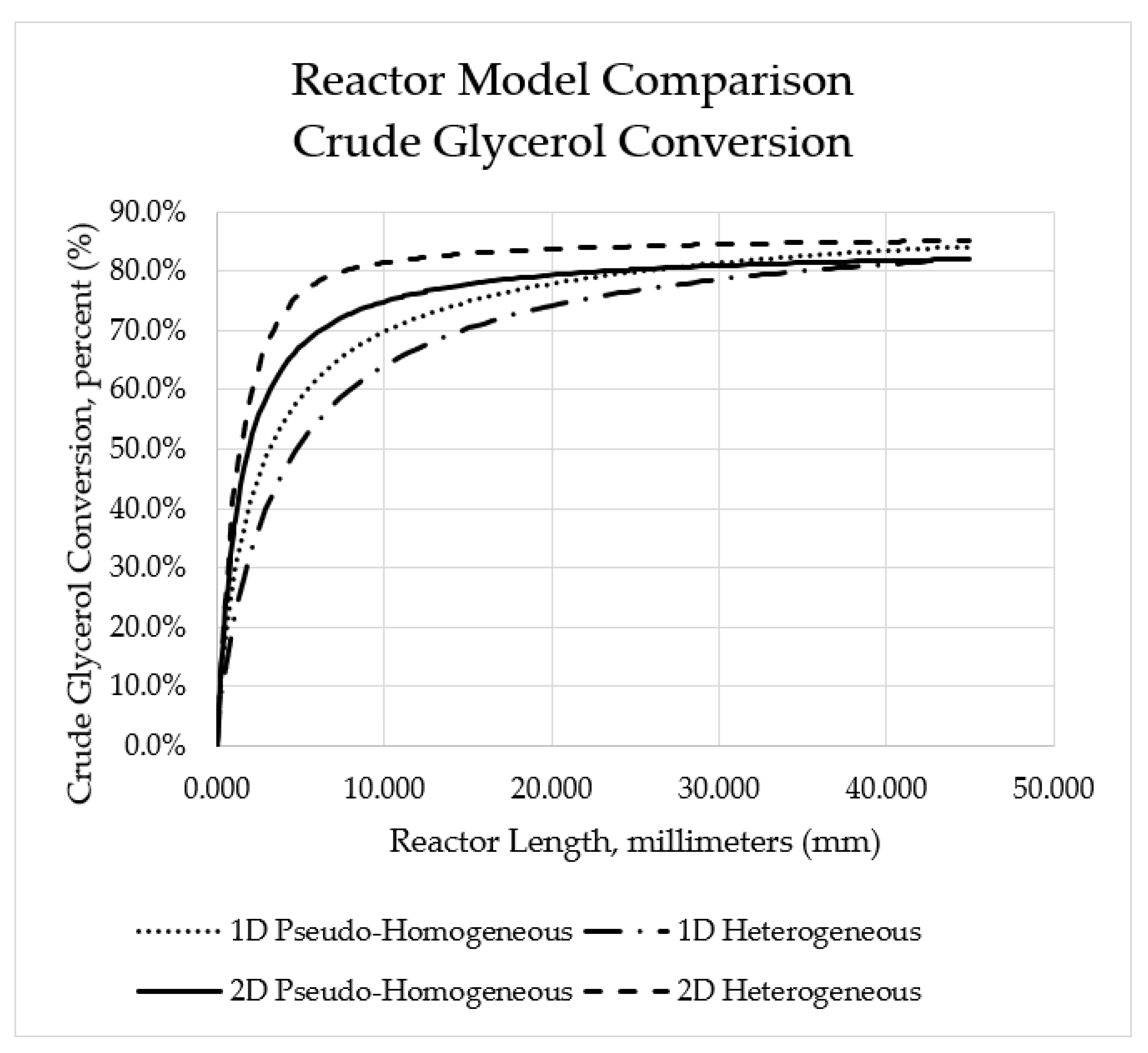
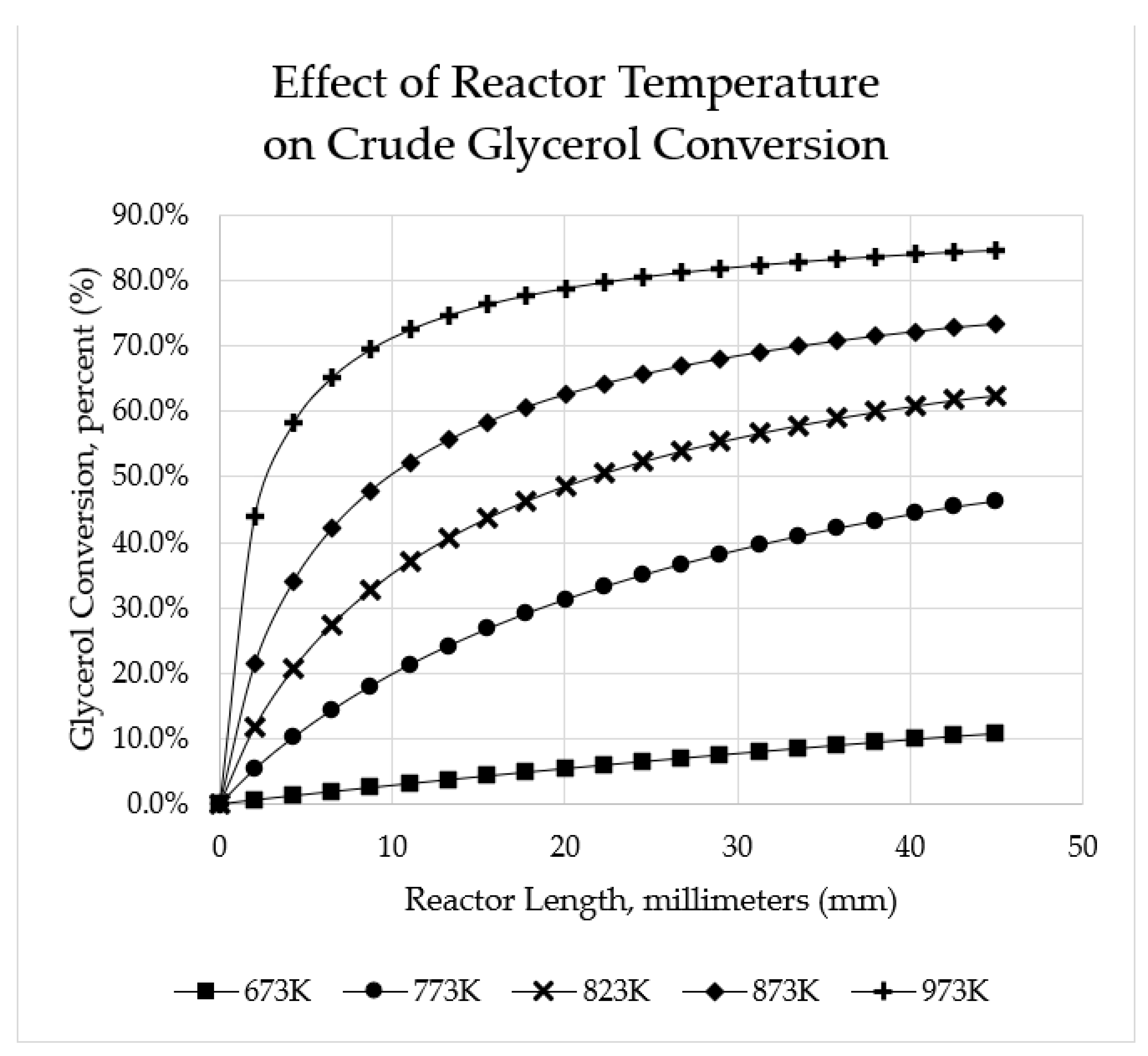


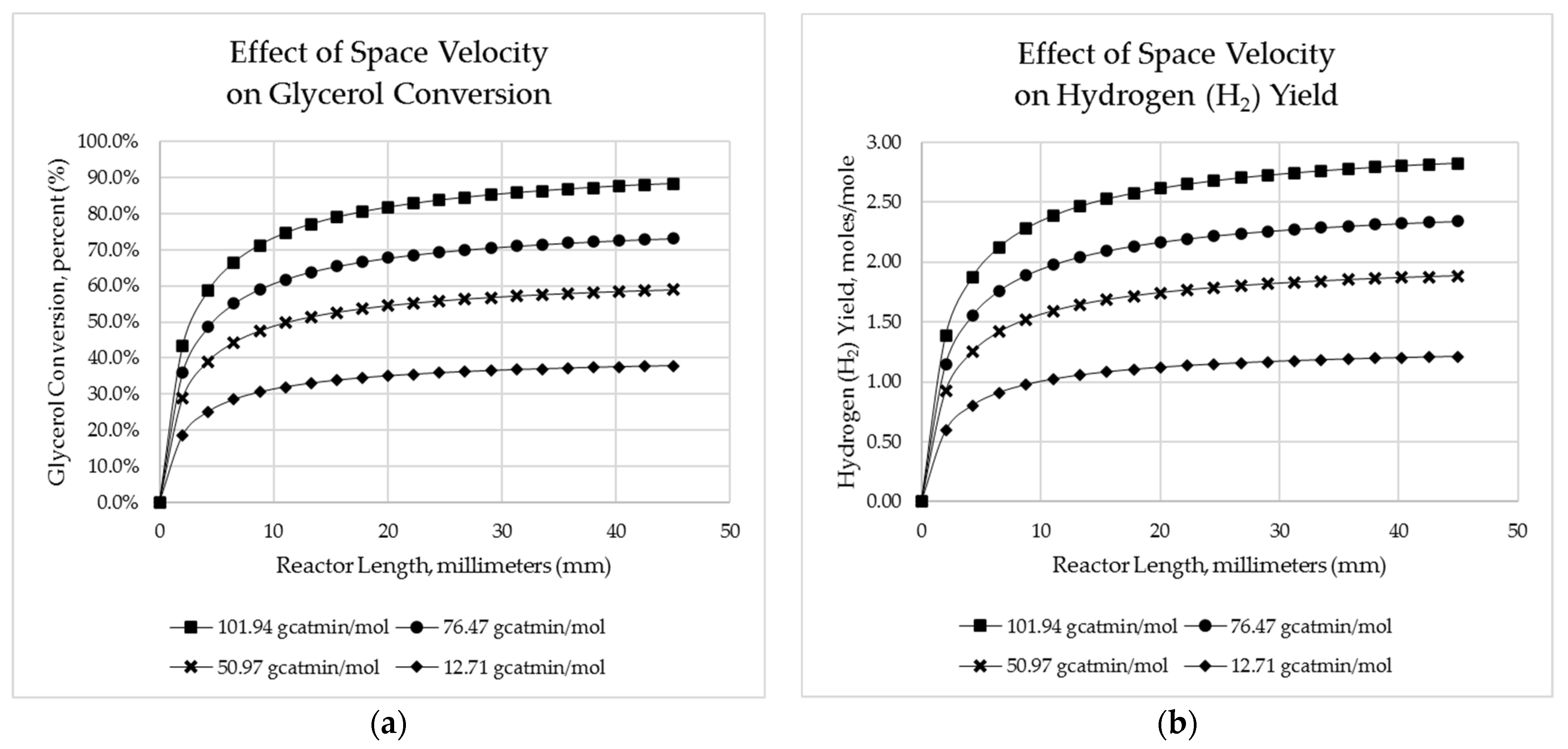

| Glycerol Products | Reaction Process | Glycerol Products | Reaction Process |
|---|---|---|---|
| Hydrogen | Oxyhydrocarbon Reforming | 1,2-propanediol | Hydrogenolysis or Fermentation |
| Glycerol carbonate | Carboxylation or Glycerolysis | 1,3-propanediol | Hydrogenolysis |
| Polyglycerol | Polymerization | Ethylene glycol | Hydrogenolysis |
| Acrolein | Dehydration | Epichlorohydrin | Halogenation |
| Acrylic Acid | Dehydration | Polyhydroxybutyrate (PHB) | Fermentation |
| 1,3-Dihydroxyacetone (DHA) | Oxidation or Fermentation | Propanol | Fermentation |
| Glyceraldehyde | Oxidation | Butanol | Fermentation |
| Glyceric acid | Oxidation | Butanediol | Fermentation |
| Glycolic acid | Oxidation | Lactic Acid | Fermentation |
| Hydroxypyruvic acid | Oxidation | Propionic acid | Fermentation |
| Mesoxalic acid | Oxidation | Citric acid | Fermentation |
| Oxalic acid | Oxidation | Succinic acid | Fermentation |
| Tartronic acid | Oxidation | Glyceric Acid | Fermentation |
| Hydroxyethanoic acid | Oxidation | Mannitol | Fermentation |
| Formic acid | Oxidation | Erythritol | Fermentation |
| Glycerol Ethers | Etherification | Arabitol | Fermentation |
| Hydrogen | Oxyhydrocarbon Reforming | 1,2-propanediol | Hydrogenolysis or Fermentation |
| Sundari and Vaidya [19] | Liu and Lawal [22] |
|---|---|
| Cheng et al. [20] | Authayanun et al. [21] |
| Atom | Compound | |||||
|---|---|---|---|---|---|---|
| - | 1 | 3 | 1 | - | - | |
| H | 2 | - | 8 | 4 | 2 | - |
| O | - | 2 | 3 | - | 1 | 2 |
| Equation (r.d.s.) | Rate Law Expression |
|---|---|
| ER_1 (Equation (20)) (Reversible) | |
| ER_2 (Equation (21)) (Reversible) | |
| ER_3 (Equation (22)) (Reversible) | |
| ER_4 (Equation (23)) (Reversible) | |
| ER_5 (Equation (20)) (Irreversible) | |
| ER_6 (Equation (21)) (Irreversible) | |
| ER_7 (Equation (22)) (Irreversible) | |
| ER_8 (Equation (23)) (Irreversible) | |
| LHHW_1 (Equation (24)) (Reversible) | |
| LHHW_2 (Equation (25)) (Reversible) | |
| LHHW_3 (Equation (26)) (Reversible) | |
| LHHW_4 (Equation (27)) (Reversible) |
| Equation (r.d.s.) | Rate Law Expression |
|---|---|
| ER_1 (Equation (28)) | |
| ER_2 (Equation (29)) | |
| ER_3 (Equation (30)) | |
| ER_4 (Equation (31)) | |
| ER_5 (Equation (32)) | |
| ER_6 (Equation (33)) | |
| ER_7 (Equation (34)) | |
| LHHW_1 (Equation (35)) | |
| LHHW_2 (Equation (36)) | |
| LHHW_2a (Equation (37)) | |
| LHHW_3 (Equation (38)) | |
| LHHW_4 (Equation (39)) | |
| LHHW_5 (Equation (40)) | |
| LHHW_6 Huang et al. [38] | |
| LHHW_7 Huang et al. [38] | Based on Huang et al. (2012) using a reversible reaction and the stoichiometry equation as an elementary reaction |
| Equation (r.d.s.) | Rate Law Expression |
|---|---|
| ER_1 (Equation (41)) | |
| ER_2 (Equation (42)) | |
| ER_3 (Equation (43)) |
| Equation (r.d.s.) | Rate Law Expression |
|---|---|
| ER_4 (Equation (42)) | |
| ER_5 (Equation (43)) | |
| ER_6 (Equation (44)) |
| Estimated Parameter | Irreversible Expression | Reversible Expression |
|---|---|---|
| - | ||
| - | ||
| - | ||
| - | ||
| - |
| Parameter | PLM | ER 3 | ER 4 | ER 5 |
|---|---|---|---|---|
| - | - | - | ||
| - | - | - | ||
| - | - | |||
| - | - | |||
| - | - | - | ||
| - | - | |||
| - | - | - | ||
| - | - | |||
| - | - | - |
| Parameter | PLM | LHHW 2 | LHHW 7 |
|---|---|---|---|
| - | - | ||
| n | - | - | |
| - | - | ||
| - | - | ||
| - | - | ||
| - | - | ||
| - | - | ||
| - | - | ||
| - | - |
| Parameter | PLM | ER 1 |
|---|---|---|
| - | ||
| - | ||
| - | ||
| - |
| Model | Parameter | Criterion 1 | Criterion 2 | Criterion 3 | |
|---|---|---|---|---|---|
| ER 4 | [J mol−1] | ||||
| [kPa−1] | |||||
| J mol−1 K−1] | |||||
| J mol−1] | |||||
| [kPa−1] | |||||
| J mol−1 K−1] | |||||
| Model | Parameter | Criterion 1 | Criterion 2 | Criterion 3 | |
|---|---|---|---|---|---|
| LHHW 2 | [J mol−1] | ||||
| [kPa−1] | |||||
| [J mol−1 K−1] | |||||
| [J mol−1] | |||||
| [kPa−1] | |||||
| [J mol−1 K−1] | |||||
| Model | Parameter | Criterion 1 | Criterion 2 | Criterion 3 | |
|---|---|---|---|---|---|
| ER 1 | [J mol−1] | < 1 | |||
| [kPa−1] | |||||
| [J mol−1 K−1] | −52.49 | ||||
| [J mol−1] | < 1 | ||||
| [kPa−1] | |||||
| [J mol−1 K−1] | −46.14 | ||||
| Reforming Process | Catalyst | Temperature (K) | Activation Energy (J/mol) | Ref. |
|---|---|---|---|---|
| Steam Reforming | Ni/CeZrCa | 773–923 | This work | |
| Ni/CeO2 | 873 | [43] | ||
| Ni/CeO2 | 673–973 | [44] | ||
| Co-Ni/Al2O3 | 773–823 | [20] | ||
| Total Oxidation | Ni/CeZrCa | 773–923 | This work | |
| N/A | N/A | (pyrolysis) | [45] | |
| La2O3 | 773–873 | (Methane) | [46] | |
| CO2 Methanation | Ni/CeZrCa | 773–923 | This work | |
| La2O3 | 773–873 | (Methane) | [46] | |
| Ni/Al(O)x | 555 | [39] |
| (52) | |
| (53) | |
| (54) | |
| (55) |
| (56) | |
| (57) | |
| (58) | |
| (59) | |
| (60) |
| Pseudo-Homogeneous | Simplified Heterogeneous | ||
|---|---|---|---|
| (61) | |
| (62) |
| (63) | |
| (64) | |
| (65) | |
| (66) |
| , | ||
| Species | Absolute Average Deviation (AAD) | |||
|---|---|---|---|---|
| 1D PH | 1D HET | 2D PH | 2D HET | |
| O2 | 3.7% | 16.2% | 7.7% | 16.2% |
| N2 | 9.1% | 12.8% | 3.9% | 3.3% |
| CO2 | 8.6% | 6.0% | 18.2% | 32.6% |
| H2 | 10.5% | 11.6% | 11.6% | 20.1% |
| CH4 | 6.1% | 8.4% | 6.6% | 0.6% |
Publisher’s Note: MDPI stays neutral with regard to jurisdictional claims in published maps and institutional affiliations. |
© 2022 by the authors. Licensee MDPI, Basel, Switzerland. This article is an open access article distributed under the terms and conditions of the Creative Commons Attribution (CC BY) license (https://creativecommons.org/licenses/by/4.0/).
Share and Cite
Odoom, A.; Fabrik, M.; Salama, A.; Shirif, E.; Ibrahim, H. Mechanistic Kinetic Modelling Framework for the Conversion of Waste Crude Glycerol to Value-Added Hydrogen-Rich Gas. Catalysts 2022, 12, 200. https://doi.org/10.3390/catal12020200
Odoom A, Fabrik M, Salama A, Shirif E, Ibrahim H. Mechanistic Kinetic Modelling Framework for the Conversion of Waste Crude Glycerol to Value-Added Hydrogen-Rich Gas. Catalysts. 2022; 12(2):200. https://doi.org/10.3390/catal12020200
Chicago/Turabian StyleOdoom, Anita, Michael Fabrik, Amgad Salama, Ezeddin Shirif, and Hussameldin Ibrahim. 2022. "Mechanistic Kinetic Modelling Framework for the Conversion of Waste Crude Glycerol to Value-Added Hydrogen-Rich Gas" Catalysts 12, no. 2: 200. https://doi.org/10.3390/catal12020200






